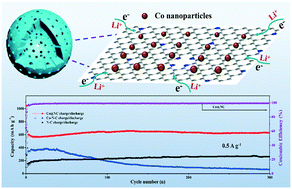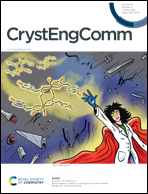Hollow porous nitrogen-doped carbon embedded with ultrafine Co nanoparticles boosting lithium-ion storage†
Abstract
Developing carbon-based nanomaterials with high capacity and stable structure as anode materials is of great significance for practical application in electronic devices. Herein, we report a facile self-template strategy to prepare hollow porous nitrogen-doped carbon embedded with ultrafine Co nanoparticles (Co@NC) based on the abundant hydroxyl functional groups on the surface of polydopamine (PDA) that can effectively anchor metal ions. The unique hollow porous structure affords large surface areas, adequate internal void space and short ion transport channels. Ultrafine Co nanoparticles embedded into hollow porous nitrogen-doped carbon offer good electronic conductivity and provide rich active sites for lithium ion adsorption (pseudocapacitance behavior) through electron transfer from metal to carbon. As the anode, Co@NC exhibited excellent cycling stability (627.5 mA h g−1 after 300 cycles at 0.5 A g−1) and remarkable rate performance (233.6 mA h g−1 at 5 A g−1). Benefiting from the unique design of the structure, Co@NC manifested a prospective anode material for stable, safe and high capacity lithium storage. Our work provides an effective strategy to synthesize hollow porous carbon embedded with ultrafine Co nanoparticles for enhancing the electrochemical performance of lithium-ion batteries.

- This article is part of the themed collection: Nanomaterials


 Please wait while we load your content...
Please wait while we load your content...